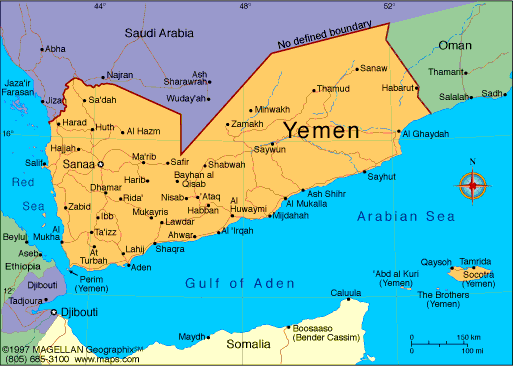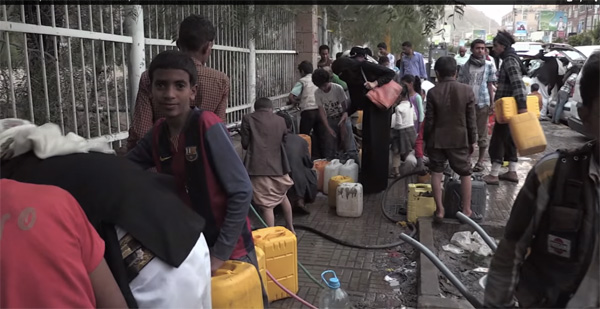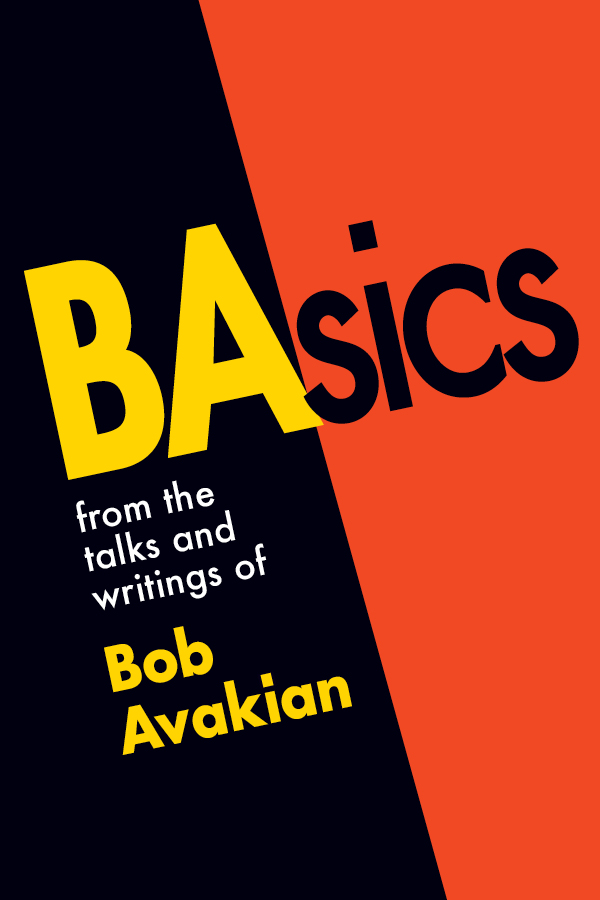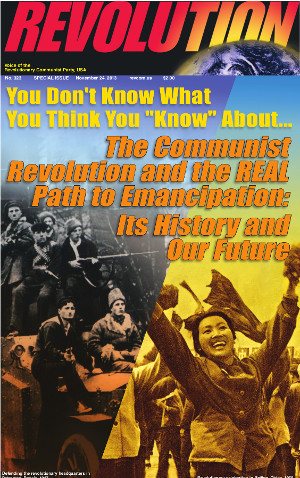From A World to Win News Service:
Yemen's civil war and the future of the Gulf
July 6, 2015 | Revolution Newspaper | revcom.us
29 June 2015. A World to Win News Service. Yemen is being devastated by a civil war that has become all the more murderous with foreign intervention. Saudi Arabia, especially, acting at the head of a coalition of Arab states and with support and military equipment from the U.S., is fighting to maintain its domination over Yemen as viciously as if the future of the House of Saud itself were at stake—which it could be. Yemen is very poor, populous, historically republican and politically turbulent. In other words, it could be a threat to the stability of the network of oil monarchies that rule over the well-off, sparse native population of the other Gulf countries.

Of Yemen’s two main cities, one, the strategic port city Aden, in the south-west, has been split in two. Refugees have crowded into the western half under the control of the old Saudi-backed regime, not necessarily because they support it but because that is the place to escape Saudi bombardment. The streets are filled with corpses and rubbish; there is no drinkable water and little food, fuel or medications. The capital, Sana'a, in the centre west, considered one of the world’s most beautiful ancient cities, is in the hands of the Houthi rebels but subject to constant Saudi air raids. Homes and other buildings in the Houthi heartland in the province of Saada in the north, near the Saudi border, are being systematically reduced to rubble.
Meanwhile, the U.S., in addition to supporting the old regime, is also militarily active in the less populated south-east of the country, carrying out drone and other attacks aimed at Al Qaeda—which, ironically, benefits from the attacks on the Houthis—and killing civilians by the score there as well.
The Saudi-led coalition air strikes have killed 2,600 people and left another 10,000 injured. The U.S. is providing targeting “advice”. About a million people have fled their homes, according to the UN, which says that three quarters of country’s population are on the verge of starvation because a naval blockade is keeping out the food and fuel imports the country depends on. This is another aspect of a military strategy designed to punish and terrorize the population. Diseases like dengue fever and malaria have begun to spread. Many people have begun to flee Yemen altogether for northern Somalia and Djibouti—and Europe, joining the millions of refugees driven from their homelands as their countries are crushed or ripped apart.
The Arab Spring came to Yemen on 27 January 2011, when thousands of students and other protesters began demonstrating in Sanaa. The initial demands were against unemployment, increasing poverty and corruption as well as plans to modify Yemen’s constitution to allow Ali Abdullah Saleh, president for more than 30 years, to continue to govern, or for his son to replace him. Soon demonstrators were calling for Saleh to follow Ben Ali and Mubarak and resign.
In Tunisia the old state was left intact and the old regime was able to make a comeback, and this was even more obviously the case in Egypt, with Saudi and U.S. manoeuvring behind the scenes, but Yemen never even experienced the illusion of a revolution. In November 2011 the Gulf Cooperation Council brokered a deal in which Saleh transferred power to his vice-president, Abd Rabbuh Mansur Hadi, in exchange for immunity from prosecution for himself and his family.

Some 80% of the people in Yemen are in desperate need of basic necessities due to long-term extreme poverty drastically worsened by Saudi Arabian attacks and fighting among other reactionary forces. Above: People getting drinking water from the UN in the streets of Sana'a. Photo: YouTube/United Nation
Of course, while the decisions were made in Riyadh and Washington, these manoeuvres had to be presented as the will of the Yemeni people. In the February 2012 presidential election, Hadi, the only candidate, won 99.8 percent of the vote. As in Tunisia and Egypt, where elections also worked against the popular revolt, as a result of this deal, “Yemen’s elite remained largely unchanged, with the same families and tribal groups controlling the country’s resources, patronage networks and political structures.” (Adam Hanieh, Lineages of Revolt, Haymarket Books, 2013) But unlike Tunisia and Egypt, the end of Saleh’s rule did little to dampen the revolt.
U.S. President Barack Obama called Yemen a model for peaceful transition in the Middle East. But by August 2014 the regime was again beginning to shake. There were several weeks of anti-government protests triggered by an extremely unpopular rise in fuel prices. This time, the Houthis, a tribal group from the north in revolt against the central government for the last decade, became heavily involved. They swept into Sanaa in September 2014. By early 2015, Hadi resigned and the Houthis were in charge of the government.
In late March 2015 a Saudi-led coalition began bombing Houthi positions. Fighter jets from Egypt, Morocco, Jordan, Sudan, the United Arab Emirates, Kuwait, Qatar and Bahrain were taking part in the operation. Somalia made its airspace, territorial waters and military bases available for the coalition to use. The United States provided intelligence and logistical support, including search-and-rescue for downed coalition pilots. It also accelerated the sale of weapons to coalition states. These include cluster bombs, banned by most countries because they are designed to kill and maim people over a broad area rather than destroy particular targets. These munitions have killed hundreds and wounded many thousands of ordinary Yemenis as they hit schools, residential buildings, health facilities, mosques, petrol stations and other civilian targets. (See the New York Times chart at http://nyti.ms/1D2Kh9K)
Saudi Arabia called for ground troops from Pakistan, a country whose military has long been allied with the U.S. and increasingly beholden to Saudi money. The Pakistani parliament voted to maintain neutrality, but the country agreed to provide warships to help the coalition anyway.
Many analysts and media tend to point to the Sunni-Shia religious conflict to explain the Saudi-led intervention in Yemen, referring to the anti-Houthi coalition members as “Sunni Arab states”. But control of Yemen has always been an important issue for Saudi Arabia in its own right. Just two years after founding Saudi Arabia, Ibn Saud, its first monarch, fought a brief war with Yemen in 1934. Details of the conflict are not particularly relevant today but its result was the Treaty of Ta’if which for the first time formally demarcated part of the border between the two countries. Since then Saudi Arabia has continually interfered in Yemen in various ways, from supporting royalist groups in the Yemen civil war in 1962-1970, to punishing Yemen for opposing the U.S.’s first invasion of Iraq (1990-91).
Using both official and unofficial “aid” (in the form of bribes to tribal leaders), the border question and the promotion of the Wahhabi brand of Salafism (Sunni fundamentalism) associated with the Saudi throne, Saudi Arabia has constantly tried to control Yemen as much as possible in order to prevent it from becoming a threat to its own stability. The increasing Salafist Islamisation of the country under Saleh and the Saudis beginning in the mid-1980s drove women out of markets and other public places and forced them to cover themselves almost entirely, along with other religious restrictions imposed on a society that had long been relatively tolerant, both in relations between religions (the majority Sunnis, Shias, Jews and others) and the relation between religion and public life.
The Houthi movement, also known as Ansar Allah (Partisans of God), says it does not aim to take over the country permanently or make their minority beliefs, the Zaydist variant of Shiaism, a state religion. In fact, not all Houthi tribes are Zaydi. But religion is a major factor, including in the cohesion of the Houthi project to end the exclusion of the Houthi tribal elites from the central power structure get their “piece of the pie” denied to them by the Saleh regime.
Iran’s geopolitical interests in working to thwart Saudi aims coincide with the Sunni-Shia divisions. But if this civil war has tended to follow religious lines it is not because it has been fuelled by ancient enmities between people of different religions who just can’t get along in Yemen, or even the Shia-Sunni conflict internationally. Actually, Saudi Arabia has followed its interests across religious lines in the past. During Yemen’s civil war (1962-1970), the Saudis, in alliance with the king of Jordan and the Shah of majority-Shia Iran, supported Shia royalists against the mostly-Sunni republican rebellion.
At least part of what has made religion a factor is the growing power and aggressive intolerance of Islamic fundamentalism in general, and the intertwining of this element with the geopolitical interests of Saudi Arabia and the U.S, and secondarily those of Iran. These interests are in sharp and growing opposition to those of Yemen’s people.
Yemen’s economy is built around a small elite drawn from the military, tribes, political class and private sector. The patronage system is built on rents from oil exports and access to the newly liberalized economy. Around 10 key families and business groups with close ties to the ex-president control more than 80 per cent of imports, manufacturing, processing, banking, telecommunications and the transport of goods. Most of the people work on the land—where depletion of water reserves has become a barrier to agriculture—or as labourers in Yemen and other Gulf countries.
Further increasing the people’s misery is the way that the status quo is conjoined with the country’s very important geopolitical situation: the Bab-el-Mandeb strait, located between Yemen on the Arabian Peninsula, and Djibouti and Eritrea in the Horn of Africa, and connects the Red Sea to the Gulf of Aden. Most exports from the Persian Gulf that transit the Suez Canal and the pipeline under the Mediterranean also pass through Bab-el-Mandeb. It is a strategic link between the Indian Ocean and the Mediterranean Sea.
The Saudis exaggerate Iran’s role in Yemen to legitimize its intervention in Yemen. In fact Iranian support for the Houthis is not a leading factor in Yemen’s chaos. Iranian support for the Houthis is recent, and the naval blockade restricts their ability to supply arms. Iran seems to want to use its influence with the Houthis as a card in its negotiations with the West.
Saudi Arabia’s war on Yemen would not be possible without the support of the U.S. Washington is extremely concerned about control of the straits through which much Middle Eastern oil flows. It is also worried about the possible dangers of Sunni fundamentalism in the region. Up until now, the U.S. has considered the main threat to its interests to be represented by Al Qaeda in the Arabian Peninsula, concentrated in Yemen’s sparsely populated south-east and the target of U.S. drone attacks but not Saudi-led air strikes.
Just as the Houthis seek to form a broad coalition on any basis possible against the Saudis and their current puppet, including with old regime military units and now even, paradoxically, Saleh himself, Saudi Arabia seems happy to let Al-Qaeda flourish as long as it targets the Houthis. Now Daesh (Islamic State) has made a dramatic entrance into this scene with car bombs and other attacks in Sanaa signalling their goal of wiping out the “Houthi apostates”. It seems that there is support for Daesh among the Saudi elite, but Daesh’s project for a caliphate is risky for the monarchy.
Saudi Arabia, a site of capital accumulation in its own right and no longer just an appendage of the U.S. and the UK, has every interest in maintaining Yemen’s unjust economic and social system and political structures. In turn, Saudi Arabia and its Gulf allies are both pillars of the political, social and economic order imperialism has imposed on the Arab world, and sources of disruption to this order. All these factors powerfully intersect with religion, including the rise of fundamentalism on a regional and even global scale.
Therefore the U.S.’s position is complex: whereas it backs Saudi Arabia in this war, its aims are not identical, and it is intervening independently of the Saudis, Qatar (where a U.S. Naval fleet is based) and their coalition.
Many of Yemen’s youth, in a country where half the population is under 20, know there is no future for them in the system. Saudi Arabia knows that. Iran and the U.S. know it too. That’s why Yemen has become a focus of crisis, a continuing source of upheaval in the Gulf and the Middle East as whole, a region that is becoming more and more explosive.
A World to Win News Service is put out by A World to Win magazine, a political and theoretical review inspired by the formation of the Revolutionary Internationalist Movement, the embryonic center of the world's Marxist-Leninist-Maoist parties and organizations.
Volunteers Needed... for revcom.us and Revolution
If you like this article, subscribe, donate to and sustain Revolution newspaper.






